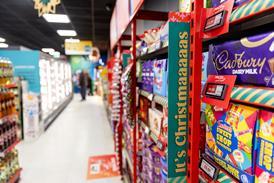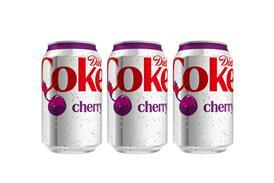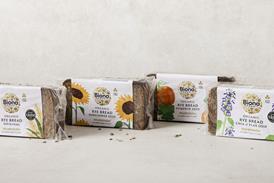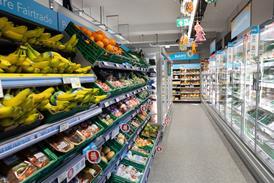Between 3pm and 5pm a whopping one-third of UK adults have yet to decide what they’re having for dinner that evening, according to HIM’s 2013 Shopwaves research. And where better to source a delicious dish than their local convenience store?
The evening meal shopping mission drives the highest number of visits to convenience stores, Spar points out. “In fact, 29% of prepared meals are bought in convenience stores, which substantially over-indexes in this category,” claims Spar UK brand director Susan Darbyshire.
Matches made in heaven
Mains and accompaniments are the items that should be positioned next to each other in stores.
• Pasta with sauce
• Pizza with garlic bread and salad
• Indian curries with onion bhajis, naan breads, mango chutney, poppadum
• Stir fry solution: stir fry veg, noodles, stir fry sauces and fresh chicken
• Sausages with prepared mash and fresh gravy
• Family pies or ready meals with prepared vegetables
• Meal deal: main/side/dessert and wine
Source: Spar
Londis retail director John Pattison adds: “With traditional meal times no longer the norm, shoppers are looking for quick answers; for what they want to eat and drink in the next hour, for dinner that evening; and the staples for tomorrow. Ultimately, they want their lives to be made easier. Getting this offer right can drive loyalty, repeat visits and shopping the rest of the store - boosting basket spend and turnover.”
The emphasis is most definitely on fast, straightforward solutions, notes Tim Ellis, business development manager at retail marketing agency Momentum Instore. “For the past few years there has been an obvious ongoing increase in the number of consumers who are time poor, and this shows no signs of slowing down any time soon. The food-for-tonight offering meets the needs of such consumers by providing a quick and simple meal solution that requires little thought or pre-planning.”
Nick Widdowson, Unilever’s expert in small store format ranging and merchandising, concurs. “In the UK, the average time taken to prepare a meal is 18.06 minutes - not long, when you consider that people might be spending a much longer time preparing a weekend family meal such as a roast.”
Rav Garcha, who owns three Nisa stores and one unaffiliated outlet in the West Midlands, claims that convenience retailers are keen to cater for food-for-tonight shoppers, but as yet many haven’t fine-tuned their offering. “The demand has always been there, but now convenience retailers are recognising it. However, they aren’t making the most of it - there’s a lot to take into account.”
Part of the problem is sourcing high-quality options and ensuring that there is plenty of choice, says Rav. “We do six or seven ready meals - we’ve dabbled in red Thai curry, sweet & sour chicken, and a korma, all of which come with rice - and we might have lasagne, a shepherd’s pie, hot pot, or cottage pie. They retail at two for five pounds, so they’re cheap and consumable, but the problem is that they are forgettable. If you think of the food -for-tonight mission, it isn’t a special occasion, but it has to be nice and appetising.”
He says that his offering doesn’t compare with the likes of Marks & Spencer and Budgens, which provide a selection of meal components in a ready-to-heat-and-eat format. “Nisa’s ready meal range is fine, but we need the whole package - an offering of sides, mains and puddings. The number of times people come in after work, pick up a basket and then just stand at the chiller staring into dead space… They want to pick from column a, column b and column c and, hey presto, they have a complete meal.”
Vic Grewal, who owns a Budgens store in Chorleywood, Hertfordshire, has been benefitting from exactly such an offering with Budgens’ Discover the Taste range. Launched in November, the range comprises a choice of main, side and dessert. The selection of two-person ready-meals includes dishes such as chicken Provençal and slow-cooked pork belly, retailing at £5 each, and sides and puddings at two for £5, providing a three-course meal for two for £10. Budgens stores - and more recently Londis - also have access to a range of semi-prepared Made Easy meals, which are pricemarked and quick to prepare.
“There’s a growing trend for consumers to purchase semi-prepared, as the need for fresh evening meals with a certain level of cooking involved increases,” explains Pattison.
Vic has adapted both his Budgens store and his smaller Simply Fresh outlet in Thames Ditton, Surrey, to make it as easy as possible for shoppers in need of meal inspiration. “Your food-for-tonight offering needs to be in the first aisle within the fresh and chilled section if possible. If the customer can find something ready made, then that’s fine, but sometimes they want to cook for themselves. If they don’t fancy the ready meals, they’ll look for something quick to prepare, using meat, spices, sauces and produce.”
FAST FACTS
• Meal for tonight shoppers are the highest spending shopping mission
• 73% of food bought for evening meals is for adults only
• 32% of food bought for evening meals are consumed by just the shopper
• 1 in 3 meal for tonight shoppers have kids in household and 26% are buying for kids- a range of kids dinner products are needed to drive this mission
• Chilled, fresh and bakery are the top categories purchased
• More fresh (meat, veg, pizza’s) would encourage shoppers to use the store more for meal for tonight
• Over half of meal for tonight shoppers walk to stores- keep pack sizes small
• They are very promotionally driven and this is the main reason for impulse so cross category promotions on meal for tonight products can help drive the mission
• Better value for money would encourage 10% of c-store shoppers to use a store to buy evening meal solutions more in the next 12 months
• 77% of shoppers said it would be useful to have commonly purchased products merchandised together
• 54% said ‘this store’ could make it easier to find products which go together
• 40% of shoppers would be encouraged to purchase products more regularly from a c-store if it did cross category promotions
Source: him! CTP 2013
Widdowson notes that displaying these items close to one another is a winning formula. “Stocking the right products, with appropriate imagery to inspire the shopper, maintaining availability, and merchandising the fixture with appropriate adjacencies, are key to maximising the opportunity.
“Retailers should stick to a tight range of the most popular brands and formats, including both ready-made and dry packet sauces. Customers shop initially by type of meal - Indian, Italian and so on - then for their preferred brand. Stocking products accordingly will help shoppers find a suitable alternative easily and you won’t miss out on sales.”
He adds that it’s important to allocate the right amount of space across all segments - too little space for Italian sauces is likely to result in out of stocks on big-selling brands and SKUs. Equally, too little space for areas such as Indian sauces may limit trial and discourage shoppers. “Our research tells us that customers shopping for this category are unlikely to replace one segment with another, for example, Italian instead of Indian.”
Princes, which owns the Italian Napolina brand, also advises retailers to place linked items together. “Napolina is aiming to grow the category by inspiring shoppers at the point of purchase and offering complete meal solutions by merchandising complementary products, such as pasta and pasta sauces, on shelf together,” says convenience channel marketing director Graham Breed.
Rav has been successful in zoning areas of his store by foods of different ethnic origins. “About a year-and-a-half ago I re-planned our world foods section in order of countries and realised that while tinned tomatoes were in the tinned veg section, we actually needed them second-sited in the Italian section so that people could find them easily with their pasta and tomato purée. It made a real difference.”
David Charman of Spar Parkfoot in Kent has also seen the benefits of grouping items together via country. “What we have done really well at is to have themed ranges, such as Spar’s Italian range, where everything from pizza and pasta, to garlic bread and sauce, is in one place. We quite often see people getting a whole meal from the one area.”
David also offers a wide selection of sauces to accompany his fresh meat offering. “We have various cooking sauces with the butchery meat so that people can be inspired to do something with it - it makes them realise ‘actually, I could mix it with this sauce, or add this seasoning’. Our butcher makes his own marinades, too.”
Vic also ensures that his complementary food-for-tonight components are within easy reach of each other. “In Chorleywood we are offering a curry package where customers can buy two curries, rice, and naan bread. It all comes in one bag with beer or wine next to it. We change our offer regularly and sometimes Budgens comes up with ideas, such as buying the ingredients for a meal at a special price.
“In smaller stores, like our Thames Ditton shop, we don’t have the space to do a full food-for-tonight display, but we have ingredients such as meat, spices, sauces and fresh veg all near each other so that it is easy for consumers to plan a meal. In between the chillers we have installed an ambient column and created a rack of shelves to hold spices. You can see people picking them up with their meat.”
Rav has also been experimenting with product adjacencies, but doesn’t feel he’s cracked it yet. “We tried to put herbs with fresh meat, but that didn’t really work,” he says. “They were on a clip-strip and after a while it just started to look tatty. The problem with clip-strips is that when staff ask ‘where do I put this?’ it’s a case of ‘oh, just put it there’. It’s not like, say, a case of Foster’s where it has a set position in store.”
However, he is keen to improve his offering and has sought inspiration from other retailers. “I went to see Roli Ranger, who owns Londis Ascot in Berkshire. His store has a strong focus on product adjacencies and he gave me a sample of shelf-edge holders. I am just deciding whether I want to use them for recipe cards, or sauces. I also went to Morrisons and noticed that they had a display of Colman’s flavourings in Perspex parasite units.”
Cooking sauces, in particular, offer customers an easy solution to ‘what to eat tonight’, according to Unilever. “It is a growing market, with plenty of innovation and good margins,” says Widdowson. “Ready to eat (ambient) sauces represent about three-quarters of the total cooking sauces market, while dry packet sauces account for nearly 15%. Baking bags are a new sector and although smaller are growing at 265% year on year. It’s also worth noting that half of all of dry cooking sauces are bought by households of three or more, which adds opportunity for incremental spend.”
Beers, wines and spirits, in particular, present an ideal proposition to pair with other products, Pattison notes. For example, you could have meat or fish with signposting to a recommended wine, or the promotion of beer next to pizza during a major sporting event.
If meal components cannot be positioned next to one another because one is chilled and the other is ambient, for example, then Darbyshire advises retailers to highlight the meal components using POS solutions, gondola end themes across the store, and baskets attached to the front of chillers.
Widdowson suggests that technology could help in this. “Recipe and shopping apps can help the shopper to identify the products that will make up the meal, and help locate them in store. While physical space may be limited, using the store environment to help shoppers find what they are looking for, or explore more areas than they had planned, will enable a retailer to gain incremental sales and make the shopping experience better for their customers.”
Rav is the first to admit that the food-for-tonight offering in c-stores is a work in progress. “At the moment, we’re still trying to get the basics right,” he says. “There is a market there, but we can’t do it on our own. We need support from the supply chain. There needs to be collaboration across different categories to allow us to offer different food combinations as part of a food-for-tonight solution. If M&S can do it then why can’t we?”
Merchandising tips
- Stick to a tight range of the most popular brands and formats to pull meal combinations together, including both ready-made sauces and dry packet sauces
- Customers shop initially by type of meal - Indian, Italian and so on - then look for their preferred brand. Stocking products in this way will help shoppers easily find a suitable alternative if their preferred brand isn’t stocked
- Make it easy for customers to find the other ingredients they need to complete their meal - rice, pasta, vegetables, cheese - with signage or by keeping the products close by
- Post-holiday periods are a key time as busy mums need a quick solution to feeding the family.
- Merchandise meal deals in an end bay and include main/side/dessert and wine
- Use digital media channels such as Facebook and Twitter to inspire recipe ideas
- Run a weekly meal plan so customer can organise their meals for the coming week and save money
- Take advantage of advertising - TV, press, in-store radio, free in-store magazine
- Encourage customers to try new products with special promotions or sampling in store.
Source
Sarah Britton

























No comments yet